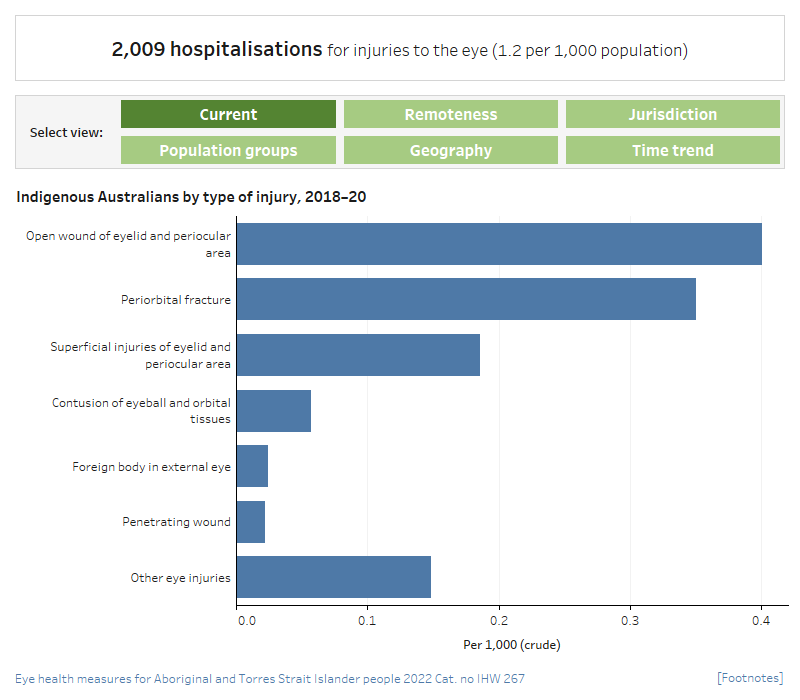Hospitalisations for eye injuries
Measure 3.2: The number of hospitalisations for injuries to the eye, per 1,000 Indigenous population.
Hospitalisations reflect both the occurrence in the population of eye conditions which are serious enough to require hospitalisation, as well as access to and use of hospitals services.
Figure 3.2: Hospitalisations for eye injuries
There are 8 separate charts for this measure showing hospitalisation rates for injuries to the eye, for Indigenous and non-Indigenous Australians, by various characteristics.
Hospitalisations for Indigenous Australians for injuries to the eye, by type of injury, 2018–20
This horizontal bar chart compares the hospitalisation rate for Indigenous Australians for injuries of the eye, in 2018–20, by type of injury. The chart shows that the most common type of injuries were open wounds of the eyelid and periocular area and periorbital fracture (both 0.4 per 1,000) followed by superficial injuries of eyelid and periocular area (0.2 per 1,000) and contusion of eyeball and orbital tissues (0.1 per 1,000).
Hospitalisations for injuries to the eye, by Indigenous status and region, 2018–20
This grouped vertical bar chart compares hospitalisation rates for injuries to the eye in 2018–20, by remoteness category and Indigenous status. The chart shows that age-standardised hospitalisation rates were higher for Indigenous Australians in all regions. Indigenous injury rates were highest in Remote and very remote areas combined (2.9 per 1,000) and lowest in Major cities (0.8 per 1,000).
Hospitalisations for injuries to the eye, by Indigenous status and jurisdiction, 2018–20
This grouped vertical bar chart compares hospitalisation rates for injuries to the eye in 2018–20, by jurisdiction and Indigenous status. The chart shows that age-standardised hospitalisation rates were higher for Indigenous Australians in all jurisdictions. Indigenous injury rates were highest in Northern Territory (3.7 per 1,000) and lowest in Victoria/Tasmania (0.6 per 1,000).
Hospitalisations for Indigenous Australians for injuries to the eye, by age and sex 2018–20
This grouped vertical bar chart compares hospitalisation rates for injuries to the eye in 2018–20, by age and sex. The chart shows that hospitalisation rates for males was higher in all age groups except 25-34 and 75 and over.
Hospitalisations for Indigenous Australians for injuries to the eye, by PHN, 2018–20 (bar chart)
This horizontal bar chart compares the hospitalisation rate for injuries to the eye for Indigenous Australians in 2018–20, by PHN, grouped by state. The chart shows that the PHNs with the lowest publishable hospitalisation rates for Indigenous Australians for injuries to the eye were Tasmania, Nepean Blue Mountains and Hunter New England and Central Coast (all under 0.5 per 1,000). The PHNs with the highest hospitalisation rates for Indigenous Australians were the Northern Territory and Western Queensland (both over 3 per 1,000).
Hospitalisations for injuries to the eye, Indigenous persons by age, 2011–12 to 2019–20
This line graph shows Indigenous hospitalisation rates for injuries to the eye in 2012–13 to 2019–20, by age group. In general, rates remained fairly constant over time across all age groups except 45-54 where rates rose slightly. Hospitalisations were highest amongst the 25-34 and 35-44 age groupings.
Hospitalisations for injuries to the eye, non-Indigenous persons by age, 2011–12 to 2019–20
This line graph shows non-Indigenous hospitalisation rates for injuries to the eye in 2012–13 to 2019–20, by age group. Rates remained fairly constant over time across for all age groups except 65–74 and 75+ where rates rose slightly. Hospitalisations also rose with age. Among those aged 75+ hospitalisations are much higher than any other age groups. In 2019–20 the rate for those age 75+ was 1.8 compared to 0.5 for the next highest age group (65-74).
Hospitalisations for injuries to the eye, by Indigenous status, 2010–11 to 2019–20
This line graph shows hospitalisation rates for injuries to the eye, from 2010–11 to 2019–20, by Indigenous status. The chart shows that, in this period, the age standardised hospitalisation rate for Indigenous Australians for injuries to the eye increased, from 1.2 to 1.4 per 1,000. Over the same period, the rate for non-Indigenous Australians stayed generally constant at 0.4 per 1,000. The trend lines show there has been a slight increase in hospitalisation rates for eye injuries for Indigenous and non-Indigenous Australians over this time.

- In the two-year period from 2018–20, there were around 2,000 hospitalisations of Indigenous Australians for injuries to the eye—1.2 per 1,000 population.
- In 2018–20, for Indigenous Australians, the most common principal diagnosis for hospitalisations for injury to the eye was an open wound of eyelid and periocular area (0.4 per 1,000).
- In 2019–20, the age-specific hospitalisation rate for Indigenous Australians aged 35–44 (2.3 per 1,000) was more than 7 times the rate for non-Indigenous Australians of the same age (0.3 per 1,000).
- Between 2012–13 and 2019–20, the age-standardised hospitalisation rate for eye injuries for Indigenous Australians and non-Indigenous Australians was fairly constant.


